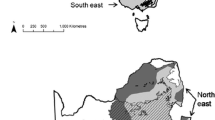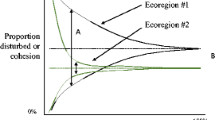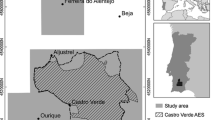Abstract
Context
Large landscapes exhibit natural heterogeneity. Land management can impose additional variation, altering ecosystem patterns. Habitat characteristics may reflect these management factors, potentially resulting in habitat differences that manifest along jurisdictional boundaries.
Objectives
We characterized the patchwork of habitats across a case study landscape, the Grand Canyon Protected Area-Centered Ecosystem. We asked: how do ecological conditions vary across different types of jurisdictional boundaries on public lands? We hypothesized that differences in fire and grazing, because they respond to differences in management over time, contribute to ecological differences by jurisdiction.
Methods
We collected plot-scale vegetation and soils data along boundaries between public lands units surrounding the Grand Canyon. We compared locations across boundaries of units managed differently, accounting for vegetation type and elevation differences that pre-date management unit designations. We used generalized mixed effects models to evaluate differences in disturbance and ecology across boundaries.
Results
Jurisdictions varied in evidence of grazing and fire. After accounting for these differences, some measured vegetation and soil properties also differed among jurisdictions. The greatest differences were between US Forest Service wilderness and Bureau of Land Management units. For most measured variables, US Forest Service non-wilderness units and National Park Service units were intermediate.
Conclusions
In this study, several ecological properties tracked jurisdictional boundaries, forming a predictable patchwork of habitats. These patterns likely reflect site differences that pre-date jurisdictions as well as those resulting from different management histories. Understanding how ecosystem differences manifest at jurisdictional boundaries can inform resource management, conservation, and cross-boundary collaborations.




Similar content being viewed by others
References
Abruzzi WS (1995) The social and ecological consequences of early cattle ranching in the Little Colorado River Basin. Human Ecol 23:75–98
Allouche O, Kalyuzhny M, Moreno-Rueda G et al (2012) Area–heterogeneity tradeoff and the diversity of ecological communities. Proc Natl Acad Sci USA 109:17495–17500
Aryal S, Cockfield G, Maraseni TN (2015) Effect of summer livestock grazing on plant species richness and composition in the Himalayan rangelands. Rangel J 37:309–321
Aslan CE, Brunson MW, Sikes BA, Epanchin-Niell RS, Veloz S, Theobald DM, Dickson BG (2020) Feedbacks between ecological and management connectivity across administrative boundaries in undeveloped landscapes. Ecosphere. https://doi.org/10.1002/ecs2.3329
Aubault H, Webb NP, Strong CL et al (2015) Grazing impacts on the susceptibility of rangelands to wind erosion: the effects of stocking rate, stocking strategy and land condition. Aeol Res 17:89–99
Augustine DJ, Frank DA (2001) Effects of migratory grazers on spatial heterogeneity of soil nitrogen properties in a grassland ecosystem. Ecology 82:3149–3162
Balch JK, Bradley BA, D’Antonio CM, Gómez-Dans J (2013) Introduced annual grass increases regional fire activity across the arid western USA (1980–2009). Glob Change Biol 19:173–183
Beckage B, Platt WJ, Gross LJ (2009) Vegetation, fire, and feedbacks: a disturbance-mediated model of savannas. Am Nat 174:805–818
Bedford FE, Whittaker RJ, Kerr JT (2012) Systemic range shift lags among a pollinator species assemblage following rapid climate change. This article is part of a special issue entitled “pollination biology research in Canada: perspectives on a mutualism at different scales. Botany 90:587–597
Best RJ, Arcese P (2009) Exotic herbivores directly facilitate the exotic grasses they graze: mechanisms for an unexpected positive feedback between invaders. Oecologia 159:139–150
Bothwell KN (2019) Practicing collaborative natural resource management with federal agencies: keys to success across partnership structures. J For 117:226–233
Bowman DMJS, Balch J, Artaxo P et al (2011) The human dimension of fire regimes on Earth. J Biogeogr 38:2223–2236
Breed GA, Stichter S, Crone EE (2013) Climate-driven changes in northeastern US butterfly communities. Nat Clim Change 3:142–145
Brooker RW, Travis JMJ, Clark EJ, Dytham C (2007) Modelling species’ range shifts in a changing climate: the impacts of biotic interactions, dispersal distance and the rate of climate change. J Theor Biol 245:59–65
Browning DM, Archer SR (2011) Protection from livestock fails to deter shrub proliferation in a desert landscape with a history of heavy grazing. Ecol Appl 21:1629–1642
Canals RM, Ferrer V, Iriarte A et al (2011) Emerging conflicts for the environmental use of water in high-valuable rangelands. Can livestock water ponds be managed as artificial wetlands for amphibians? Ecol Eng 37:1443–1452
Certini G (2005) Effects of fire on properties of forest soils: a review. Oecologia 143:1–10
Connell JH (1978) Diversity in tropical rain forests and coral reefs. Science 199:1302–1310
Cundill G, Fabricius C (2010) Monitoring the governance dimension of natural resource co-management. Ecol Soc 15:1
Cushman SA, Shirk A, Landguth EL (2012) Separating the effects of habitat area, fragmentation and matrix resistance on genetic differentiation in complex landscapes. Landscape Ecol 27:369–380
Cyphers LA, Schultz CA (2019) Policy design to support cross-boundary land management: the example of the joint chiefs landscape restoration partnership. Land Use Policy 80:362–369
Dickson BG, Roemer GW, McRae BH, Rundall JM (2013) Models of regional habitat quality and connectivity for Pumas (Puma concolor) in the Southwestern United States. PLoS ONE 8:e81898
Dixo M, Metzger JP, Morgante JS, Zamudio KR (2009) Habitat fragmentation reduces genetic diversity and connectivity among toad populations in the Brazilian Atlantic Coastal Forest. Biol Cons 142:1560–1569
D’Odorico P, Okin GS, Bestelmeyer BT (2012) A synthetic review of feedbacks and drivers of shrub encroachment in arid grasslands. Ecohydrology 5:520–530
Dorrough JW, Ash JE, Bruce S, McIntyre S (2007) From plant neighbourhood to landscape scales: how grazing modifies native and exotic plant species richness in grassland. Plant Ecol 191:185–198
Doyle-Capitman CE, Decker DJ, Jacobson CA (2018) Toward a model for local stakeholder participation in landscape-level wildlife conservation. Human Dimens Wildl 23:375–390
Epanchin-Niell RS, Hufford MB, Aslan CE et al (2010) Controlling invasive species in complex social landscapes. Front Ecol Environ 8:210–216
Fahrig L (2003) Effects of habitat fragmentation on biodiversity. Annu Rev Ecol Evol Syst 34:487–515
Fischer J, Lindenmayer DB (2007) Landscape modification and habitat fragmentation: a synthesis. Glob Ecol Biogeogr 16:265–280
Fuhlendorf SD, Engle DM, Kerby J, Hamilton R (2009) Pyric herbivory: rewilding landscapes through the recoupling of fire and grazing. Conserv Biol 23:588–598
Fulé PZ, Covington WW, Moore MM (1997) Determining reference conditions for ecosystem management of Southwestern ponderosa pine forests. Ecol Appl 7:895–908
Fulé PZ, Heinlein TA, Covington WW, Moore MM (2000) Continuing fire regimes in remote forests of Grand Canyon National Park. Proceedings: wilderness science in a time of change. Proc. RMRS-P-15. USA Department of Agriculture, Forest Service, Rocky Mountain Research Station, Ogden, pp 242–248
Gelman A, Carlin JB, Stern HS et al (2013) Bayesian data analysis, 3rd edn. CRC Press, Boca Raton
Gorte RW, Vincent CH, Hanson LA, Rosenblum MR (2012) Federal land ownership: overview and data. Congressional Research Service, Washington, DC
Haddad NM, Baum KA (1999) An experimental test of corridor effects on butterfly densities. Ecol Appl 9:623–633
Haddad NM, Brudvig LA, Clobert J et al (2015) Habitat fragmentation and its lasting impact on Earth’s ecosystems. Sci Adv 1:e1500052
Hansen AJ, Davis CR, Piekielek N et al (2011) Delineating the ecosystems containing protected areas for monitoring and management. Bioscience 61:363–373
He T, Lamont BB, Pausas JG (2019) Fire as a key driver of Earth’s biodiversity. Biol Rev 94:1983–2010
Herbst DB, Bogan MT, Roll SK, Safford HD (2012) Effects of livestock exclusion on in-stream habitat and benthic invertebrate assemblages in montane streams. Freshw Biol 57:204–217
Hessburg PF, Miller CL, Parks SA et al (2019) Climate, environment, and disturbance history govern resilience of western North American Forests. Front Ecol Evol 7:239
Holcomb CM, Sisk TD, Dickson BD, Sesnie SE, Aumack EN (2011) Administrative boundaries and ecological divergence: the divided history and coordinated future of land management on the Kaibab Plateau, Arizona, USA. In: Van Riper C, Villareal ML, van Riper CR, Johnson MJ (eds) The Colorado plateau V: research, environmental planning, and management for collaborative conservation. University of Arizona Press, Tucson, pp 1–20
Holmes G (2015) What do we talk about when we talk about biodiversity conservation in the Anthropocene? Envir Soc 6:87–108
Huffman DW, Fulé PZ, Pearson KM, Crouse JE (2008) Fire history of pinyon–juniper woodlands at upper ecotones with ponderosa pine forests in Arizona and New Mexico. Can J For Res 38:2097–2108
Jimenez Aguilar A, Huber-Sannwald E, Belnap J et al (2009) Biological soil crusts exhibit a dynamic response to seasonal rain and release from grazing with implications for soil stability. J Arid Environ 73:1158–1169
Kachergis E, Derner JD, Cutts BB et al (2014) Increasing flexibility in rangeland management during drought. Ecosphere 5:art77
Kalle R, Ramesh T, Downs CT (2018) When and where to move: dynamic occupancy models explain the range dynamics of a food nomadic bird under climate and land cover change. Glob Change Biol 24:e27–e39
Kark S, Tulloch A, Gordon A et al (2015) Cross-boundary collaboration: key to the conservation puzzle. Curr Opin Environ Sustain 12:12–24
Kerby JD, Fuhlendorf SD, Engle DM (2007) Landscape heterogeneity and fire behavior: scale-dependent feedback between fire and grazing processes. Landsc Ecol 22:507–516
Klaus NA, Buehler DA, Saxton AM (2005) Forest management alternatives and songbird breeding habitat on the Cherokee National Forest, Tennessee. J Wildl Manag 69:222–234
Knight RL, Knight RL, Landres P (1998) Stewardship across boundaries. Island Press, Washington, DC
Koontz TM, Bodine J (2008) Implementing ecosystem management in public agencies: lessons from the U.S. Bureau of Land Management and the Forest Service. Conserv Biol 22:60–69
Kutiel P, Shaviv A (1989) Effect of simulated forest fire on the availability of N and P in mediterranean soils. Plant Soil 120:57–63
LANDFIRE (2014) Homepage of the LANDFIRE project, U.S. Department of Agriculture, Forest Service; U.S. Department of Interior. Available from http://www.landfire.gov/index.php
Landres PB, Knight RL, Pickett ST, Cadenasso ML (1998) Ecological effects of administrative boundaries. In: Knight RL, Landres PB (eds) Stewardship across boundaries. Island Press, Washington, DC, pp 39–64
Le Maitre DC, Kotzee IM, O’Farrell PJ (2014) Impacts of land-cover change on the water flow regulation ecosystem service: invasive alien plants, fire and their policy implications. Land Use Policy 36:171–181
Lueck D, Yoder J (2015) The economic foundations of firefighting organizations and institutions. J For 113:291–297
Manley JT, Schuman GE, Reeder JD, Hart RH (1995) Rangeland soil carbon and nitrogen responses to grazing. J Soil Water Conserv 50:294–298
Måren IE, Kapfer J, Aarrestad PA et al (2018) Changing contributions of stochastic and deterministic processes in community assembly over a successional gradient. Ecology 99:148–157
Martin WE, Bender HW (1999) Modelling public land-use decisions as a cooperative game. Int J Environ Pollut 12:217–231
McClaran MP (1990) Livestock in wilderness: a review and forecast. Environ Law 20:857–890
Min Y, Agresti A (2005) Random effect models for repeated measures of zero-inflated count data. Stat Model 5:1–19
Monger C, Sala OE, Duniway MC et al (2015) Legacy effects in linked ecological–soil–geomorphic systems of drylands. Front Ecol Environ 13:13–19
Neff JC, Reynolds RL, Belnap J, Lamothe P (2005) Multi-decadal impacts of grazing on soil physical and biogeochemical properties in Southeast Utah. Ecol Appl 15:87–95
Ostergren DM (2006) Issues in forest restoration: wilderness management and the restoration of fire: an analysis of laws and regulations in Northern Arizona. ERI White Paper–Issues in Forest Restoration. NAU Ecological Restoration Institute
Parsons DJ, Landres PB (1996) Restoring natural fire to wilderness: how are we doing? Rocky Mountain Research Station, Fort Collins
Pausas JG, Ribeiro E (2017) Fire and plant diversity at the global scale. Global Ecol Biogeogr 26:889–897
Pearson RG (2006) Climate change and the migration capacity of species. Trends Ecol Evol 21:111–113
Pechony O, Shindell DT (2010) Driving forces of global wildfires over the past millennium and the forthcoming century. PNAS 107:19167–19170
Pellegrini AFA, Ahlström A, Hobbie SE et al (2018) Fire frequency drives decadal changes in soil carbon and nitrogen and ecosystem productivity. Nature 553:194–198
Piñeiro G, Paruelo JM, Oesterheld M, Jobbágy EG (2010) Pathways of grazing effects on soil organic carbon and nitrogen. Rangel Ecol Manag 63:109–119
Pinto RL (2014) Cattle grazing in the national parks: historical development and history of management in three Southern Arizona parks. The University of Arizona, Arizona
Prager K, Lorenzo-Arribas A, Bull H et al (2018) Social constraints in cross-boundary collaborative deer management. Ecol Soc 23:4
Kulakowski D, Seidl R, Holeksa J et al (2017) A walk on the wild side: disturbance dynamics and the conservation and management of European mountain forest ecosystems. For Ecol Manage 388:120–131
Plummer M (2003) JAGS: A program for analysis of Bayesian graphical models using Gibbs sampling. Working Papers 8
Potts SG, Vulliamy B, Roberts S et al (2005) Role of nesting resources in organising diverse bee communities in a Mediterranean landscape. Ecol Entomol 30:78–85
Quinn-Davidson LN, Varner JM (2012) Impediments to prescribed fire across agency, landscape and manager: an example from northern California. Int J Wildland Fire 21:210–218
R Core Team (2017) R: a language and environment for statistical computing. R Found. Stat. Comput, Vienna, Austria
Reimondo EL (2012) Ecological impacts and management implications of introduced bison in the Grand Canyon region, M.S. edn., Thesis, Northern Arizona University, United States
Rubin DB (1992) Computational aspects of analysing random effects/longitudinal models. Stat Med 11:1809–1821
Schuman GE, Janzen HH, Herrick JE (2002) Soil carbon dynamics and potential carbon sequestration by rangelands. Environ Pollut 116:391–396
Senner NR, Stager M, Cheviron ZA (2018) Spatial and temporal heterogeneity in climate change limits species’ dispersal capabilities and adaptive potential. Ecography 41:1428–1440
Souther S, Loeser M, Crews TE, Sisk T (2019) Complex response of vegetation to grazing suggests need for coordinated, landscape-level approaches to grazing management. Global Ecol Conserv 20:e00770
Squillace M (2014) Grazing in wilderness areas. Environ Law 44:415–445
Stamati FE, Nikolaidis NP, Venieri D et al (2011) Dissolved organic nitrogen as an indicator of livestock impacts on soil biochemical quality. Appl Geochem 26:S340–S343
Steen HK (1991) The beginning of the national forest system. U.S. Department of Agriculture, Forest Service, Washington, DC
Stortz SD, Aslan CE, Sisk TD, Chaudhry T, Rundall JM, Palumbo J, Zachmann L, Dickson B (2018) The Greater Grand Canyon Landscape Assessment: a resource condition assessment of Grand Canyon National Park and surrounding region. Natural Resource Technical Report, NPS, Fort Collins, CO
Taboada MA, Rubio G, Chaneton EJ (2015) Grazing impacts on soil physical, chemical, and ecological properties in forage production systems. Soil management: building a stable base for agriculture. Wiley, New York, pp 301–320
Theobald DM, Harrison-Atlas D, Monahan WB, Albano CM (2015) Ecologically-relevant maps of landforms and physiographic diversity for climate adaptation planning. PLoS ONE 10:e0143619
Tilman D (2004) Niche tradeoffs, neutrality, and community structure: A stochastic theory of resource competition, invasion, and community assembly. Proc Nat Acad Sci 101:10854–10861
Turner MG (2010) Disturbance and landscape dynamics in a changing world. Ecology 91:2833–2849
Turner MG, Gardner RH (2015) Landscape disturbance dynamics. In: Turner MG, Gardner RH (eds) Landscape ecology in theory and practice: pattern and process. Springer, New York, NY, pp 175–228
U.S. Forest Service (2007) Forest Service manual FSM 2300: recreation, wilderness, and related resource management. US Forest Service, Washington, DC
U.S. Geological Survey (USGS) Gap Analysis Project (GAP), 20180930, Protected Areas Database of the United States (PAD-US): PAD-US Version 2.0, U.S. Geological Survey (USGS). https://usgs.gov/gapanalysis/PAD-US/. Accessed Jan 2020
Vanschoenwinkel B, Buschke F, Brendonck L (2013) Disturbance regime alters the impact of dispersal on alpha and beta diversity in a natural metacommunity. Ecology 94:2547–2557
van Wagtendonk JW (2007) The history and evolution of wildland fire use. Fire Ecol 3:3–17
Verma S, Jayakumar S (2012) Impact of forest fire on physical, chemical and biological properties of soil: a review. Proc Int Acad Ecol Environ Sci USA 2:168–176
Virgós E, Tellería JL, Santos T (2002) A comparison on the response to forest fragmentation by medium-sized Iberian carnivores in central Spain. Biodivers Conserv 11:1063–1079
Ware IM, Terletzky P, Adler PB (2014) Conflicting management objectives on the Colorado Plateau: understanding the effects of bison and cattle grazing on plant community composition. J Nat Conserv 22:293–301
Wolf JJ, Mast JN (1998) Fire history of mixed-conifer forests on the North Rim, Grand Canyon National Park, Arizona. Phys Geogr 19:1–14
Acknowledgements
This work was supported by National Science Foundation Award #1617309. Many thanks to the jurisdictional managers across the study area for allowing our sampling to occur, and to the Grand Canyon Trust for lending field resources to support our crews. We are grateful for the field staff who worked tirelessly to collect the immense amount of data examined here, including: M. Sample, B. Tiffany, S. Sterner, M. Sotelo, G. Conley, M. Barasha, and M. Andrews.
Author information
Authors and Affiliations
Corresponding author
Additional information
Publisher's Note
Springer Nature remains neutral with regard to jurisdictional claims in published maps and institutional affiliations.
Supplementary Information
Below is the link to the electronic supplementary material.
Rights and permissions
About this article
Cite this article
Aslan, C.E., Zachmann, L., McClure, M. et al. Quantifying ecological variation across jurisdictional boundaries in a management mosaic landscape. Landscape Ecol 36, 1215–1233 (2021). https://doi.org/10.1007/s10980-021-01198-7
Received:
Accepted:
Published:
Issue Date:
DOI: https://doi.org/10.1007/s10980-021-01198-7




